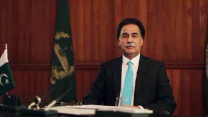Court Martial: ‘A Few Good Men’ with a theatrical spin
Director manages to engage audience with mysterious twists despite a predictable climax.

Director manages to engage audience with mysterious
twists despite a predictable climax. PHOTO: PUBLICITY
The curtain opens, and you see a battalion of patriotic soldiers dressed in crisp uniforms rushing around the stage, as if on a battlefield. But as the lights come on, you see a courtroom where soldiers are mere guards.
The director of Court Martial, Sunil Shankar, sticks to his signature style by playing around with stage space and offering the right amount of ambiguity before restricting audiences to the setting of a courtroom. As different soldiers take up their designated positions on stage, you are intrigued and left feeling that you have a major stake in what is about to unfold.
Colonel Surat Singh (Adnan Jaffar) presides over the possible court martial of Ram Chandar (Kashif Hussain), who is accused of killing a senior officer and injuring Captain B D Kapoor (Fawad Khan), who is also present in the courtroom. Although incapacitated, Chandar remains attentive to the courtroom proceedings.
While Jaffar’s voice may have been the primary reason for his casting, his acting and expressions have hardly evolved from his last portrayal as Ghalib in Manto Aur Ghalib: Ek Guftagu. His voice turns out to be his biggest strength, as well as weakness. The prosecutor Major Ajay Puri (Ali Rizvi) fits perfectly into his character and makes sure that through his performance and arguments, there is no way out for Ram Chandar. The defendant Captain Bekash Rai (Nazarul Hasan) is the ‘undermined’ Bengali but the only philosophical voice in the play – someone who follows the law but isn’t shy of pointing out its hollowness. For Hasan, the role seems like a piece of cake.

In a nutshell, the play is more or less like Rob Reiner’s A Few Good Men but the similarity doesn’t take away from its charisma. Shankar manages to bombard audiences with one dramatic crescendo after another, even when Swadesh Deepak’s script doesn’t have much to offer.
To avoid possible objections, the design of the soldiers’ uniform does not appear to be similar to that of any particular country’s army. However, an observant viewer would note the Gestapo-like feel to the uniform and that the high-ranking officers’ jackets bear resemblance to those of Indian army officers. Interestingly, the play showcases the hierarchical structure of the Indian army to comment on the inequalities within the caste system. Aesthetically speaking, the set is simple but wide, and gives the courtroom drama a larger than life feel – something that is not easy to achieve when most of your action takes place around a witness box.
Seasoned actors like Mesum Naqvi as Captain Dr Gupta and Ovais Mangalwala as Subedar Bhalwan Singh spend limited time on stage but leave a lasting impression. Mangalwala’s experience coupled with a structured script manages to make you laugh pre-interval and cry post-interval. Fawad Khan as Kapoor is way more convincing than his portrayal of Ghalib in a later version of Manto Aur Ghalib: Ek Guftagu and what really takes you by surprise is the comfort with which he switches between Nagauri (Rajasthani) and Indian-English accents.
The story doesn’t really have a climax because it is evident that Ram Chandar will be punished from the very beginning, but you will still look forward to the plot being unfolded and resolved. This is where Shankar deserves credit — for pulling off one of the most engaging plays at Napa despite an ordinary script.
Published in The Express Tribune, October 10th, 2013.
Like Life & Style on Facebook, follow @ETLifeandStyle on Twitter for the latest in fashion, gossip and entertainment.



















COMMENTS
Comments are moderated and generally will be posted if they are on-topic and not abusive.
For more information, please see our Comments FAQ